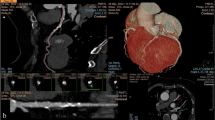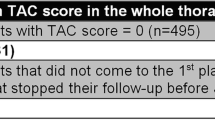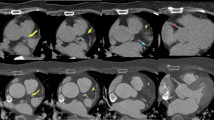Abstract
Objectives
To investigate the association between directly measured density and morphology of coronary artery calcium (CAC) with cardiovascular disease (CVD) events, using computed tomography (CT).
Methods
Framingham Heart Study (FHS) participants with CAC in noncontrast cardiac CT (2002–2005) were included and followed until 2016. Participants with known CVD or uninterpretable CT scans were excluded. We assessed and correlated (Spearman) CAC density, CAC volume, and the number of calcified segments. Moreover, we counted morphology features including shape (cylindrical, spherical, semi-tubular, and spotty), location (bifurcation, facing pericardium, or facing myocardium), and boundary regularity. In multivariate Cox regression analyses, we associated all CAC characteristics with CVD events (CVD-death, myocardial infarction, stroke).
Results
Among 1330 included participants (57.8 ± 11.7 years; 63% male), 73 (5.5%) experienced CVD events in a median follow-up of 9.1 (7.8–10.1) years. CAC density correlated strongly with CAC volume (Spearman’s ρ = 0.75; p < 0.001) and lower number of calcified segments (ρ = − 0.86; p < 0.001; controlled for CAC volume). In the survival analysis, CAC density was associated with CVD events independent of Framingham risk score (HR (per SD) = 2.09; 95%CI, 1.30–3.34; p = 0.002) but not after adjustment for CAC volume (p = 0.648). The extent of spherically shaped and pericardially sided calcifications was associated with fewer CVD events accounting for the number of calcified segments (HR (per count) = 0.55; 95%CI, 0.31–0.98; p = 0.042 and HR = 0.66; 95%CI, 0.45–0.98; p = 0.039, respectively).
Conclusions
Directly measured CAC density does not predict CVD events due to the strong correlation with CAC volume. The spherical shape and pericardial-sided location of CAC are associated with fewer CVD events and may represent morphological features related to stable coronary plaques.
Key Points
• Coronary calcium density may not be independently associated with cardiovascular events.
• Coronary calcium density correlates strongly with calcium volume.
• Spherical shape and pericardial-sided location of CAC are associated with fewer CVD events.



Similar content being viewed by others
Abbreviations
- AS:
-
Agatston score
- AUC:
-
Area under the curve
- BMI:
-
Body mass index
- CAC:
-
Coronary artery calcium
- CT:
-
Computed tomography
- CVD:
-
Cardiovascular disease
- FHS:
-
Framingham Heart Study
- FRS:
-
Framingham risk score
- HU:
-
Hounsfield units
- ICC:
-
Intra-class correlation coefficient
- IVUS:
-
Intravascular ultrasound
- LAD:
-
Left anterior descending
- LCx:
-
Left circumflex artery
- MESA:
-
Multi-Ethnic Study of Atherosclerosis
- RCA:
-
Right coronary artery
- VIF:
-
Variance inflation factor
References
Nakahara T, Dweck MR, Narula N et al (2017) Coronary artery calcification: from mechanism to molecular imaging. JACC Cardiovasc Imaging 10:582–593. https://doi.org/10.1016/j.jcmg.2017.03.005
Nasir K, Clouse M (2012) Role of nonenhanced multidetector CT coronary artery calcium testing in asymptomatic and symptomatic individuals. Radiology 264:637–649. https://doi.org/10.1148/radiol.12110810
Agatston AS, Janowitz WR, Hildner FJ, Zusmer NR, Viamonte M Jr, Detrano R (1990) Quantification of coronary artery calcium using ultrafast computed tomography. J Am Coll Cardiol 15:827–832
Criqui MH, Denenberg JO, Ix JH et al (2014) Calcium density of coronary artery plaque and risk of incident cardiovascular events. JAMA 311:271–278. https://doi.org/10.1001/jama.2013.282535
Criqui MH, Knox JB, Denenberg JO et al (2017) Coronary artery calcium volume and density. JACC Cardiovasc Imaging 10:845–854. https://doi.org/10.1016/j.jcmg.2017.04.018
Shaw LJ, Min JK, Nasir K et al (2018) Sex differences in calcified plaque and long-term cardiovascular mortality: observations from the CAC Consortium. Eur Heart J 39:3727–3735. https://doi.org/10.1093/eurheartj/ehy534
Lee JB, Mintz GS, Lisauskas JB et al (2011) Histopathologic validation of the intravascular ultrasound diagnosis of calcified coronary artery nodules. Am J Cardiol 108:1547–1551. https://doi.org/10.1016/j.amjcard.2011.07.014
Cardoso L, Kelly-Arnold A, Maldonado N, Laudier D, Weinbaum S (2014) Effect of tissue properties, shape and orientation of microcalcifications on vulnerable cap stability using different hyperelastic constitutive models. J Biomech 47:870–877. https://doi.org/10.1016/j.jbiomech.2014.01.010
Kataoka Y, Wolski K, Uno K et al (2012) Spotty calcification as a marker of accelerated progression of coronary atherosclerosis: insights from serial intravascular ultrasound. J Am Coll Cardiol 59:1592–1597. https://doi.org/10.1016/j.jacc.2012.03.012
Motoyama S, Kondo T, Sarai M et al (2007) Multislice computed tomographic characteristics of coronary lesions in acute coronary syndromes. J Am Coll Cardiol 50:319–326. https://doi.org/10.1016/j.jacc.2007.03.044
Asakura T, Karino T (1990) Flow patterns and spatial distribution of atherosclerotic lesions in human coronary arteries. Circ Res 66:1045–1066. https://doi.org/10.1161/01.RES.66.4.1045
Chatzizisis YS, Jonas M, Coskun AU et al (2008) Prediction of the localization of high-risk coronary atherosclerotic plaques on the basis of low endothelial shear stress: an intravascular ultrasound and histopathology natural history study. Circulation 117:993–1002. https://doi.org/10.1161/CIRCULATIONAHA.107.695254
Hoffmann U, Massaro JM, Fox CS, Manders E, O'Donnell CJ (2008) Defining normal distributions of coronary artery calcium in women and men (from the Framingham Heart Study). Am J Cardiol 102:1136–1141.e1. https://doi.org/10.1016/j.amjcard.2008.06.038
D’Agostino RB Sr, Vasan RS, Pencina MJ et al (2008) General cardiovascular risk profile for use in primary care: the Framingham Heart Study. Circulation 117:743–753. https://doi.org/10.1161/CIRCULATIONAHA.107.699579
Goff DC Jr, Lloyd-Jones DM, Bennett G et al (2014) 2013 ACC/AHA guideline on the assessment of cardiovascular risk: a report of the American College of Cardiology/American Heart Association Task Force on Practice Guidelines. J Am Coll Cardiol 63:2935–2959. https://doi.org/10.1016/j.jacc.2013.11.005
3D Slicer. Available via https://www.slicer.org/. Accessed 16 Jun 2017
Detrano R, Guerci AD, Carr JJ et al (2008) Coronary calcium as a predictor of coronary events in four racial or ethnic groups. N Engl J Med 358:1336–1345. https://doi.org/10.1056/NEJMoa072100
Greenland P, LaBree L, Azen SP, Doherty TM, Detrano RC (2004) Coronary artery calcium score combined with Framingham score for risk prediction in asymptomatic individuals. JAMA 291:210–215. https://doi.org/10.1001/jama.291.2.210
Hoffmann U, Massaro JM, D'Agostino RB Sr, Kathiresan S, Fox CS, O'Donnell CJ (2016) Cardiovascular event prediction and risk reclassification by coronary, aortic, and valvular calcification in the Framingham Heart Study. J Am Heart Assoc 5. https://doi.org/10.1161/JAHA.115.003144
Blaha MJ, Budoff MJ, Tota-Maharaj R et al (2016) Improving the CAC score by addition of regional measures of calcium distribution: Multi-Ethnic Study of Atherosclerosis. JACC Cardiovasc Imaging 9:1407–1416. https://doi.org/10.1016/j.jcmg.2016.03.001
Brown ER, Kronmal RA, Bluemke DA et al (2008) Coronary calcium coverage score: determination, correlates, and predictive accuracy in the Multi-Ethnic Study of Atherosclerosis. Radiology 247:669–675. https://doi.org/10.1148/radiol.2473071469
Ferencik M, Pencina KM, Liu T et al (2017) Coronary artery calcium distribution is an independent predictor of incident major coronary heart disease events: results from the Framingham Heart Study. Circ Cardiovasc Imaging 10:e006592. https://doi.org/10.1161/CIRCIMAGING.117.006592
Bellasi A, Ferramosca E, Ratti C, Block G, Raggi P (2016) The density of calcified plaques and the volume of calcium predict mortality in hemodialysis patients. Atherosclerosis 250:166–171. https://doi.org/10.1016/j.atherosclerosis.2016.03.034
Mukai H, Dai L, Chen Z et al (2018) Inverse J-shaped relation between coronary arterial calcium density and mortality in advanced chronic kidney disease. Nephrol Dial Transplant. https://doi.org/10.1093/ndt/gfy352
Stone PH, Saito S, Takahashi S et al (2012) Prediction of progression of coronary artery disease and clinical outcomes using vascular profiling of endothelial shear stress and arterial plaque characteristics: the PREDICTION Study. Circulation 126(2):172–181. https://doi.org/10.1161/CIRCULATIONAHA.112.096438
Acknowledgments
This study used in part data and resources from the Framingham Heart Study of the National Heart, Lung, and Blood Institute of the National Institutes of Health and Boston University School of Medicine. Dr. Borek Foldyna, Dr. Udo Hoffmann, and Dr. Christopher J. O’Donnell have had full access to all the study data and take responsibility for the data integrity and the analysis accuracy.
Our project was presented at the SCCT 2018 in Dallas, TX, USA, and received the Siemens Outstanding Academic Research (SOAR) award.
Funding
The authors state that this work has not received any funding.
Author information
Authors and Affiliations
Corresponding author
Ethics declarations
Conflict of interest
Dr. Foldyna received unrelated funding from the German Research Foundation (DFG), project 290004377 (FO993/1) and support from the National Institutes of Health 5K24HL113128-07. Dr. Hoffmann received unrelated Research Grants (U01HL092040, U01HL092022, Heart Flow Inc., MedImmune; KOWA Inc.). Dr. Ferencik reports receiving an unrelated grant from the American Heart Association. This work was further supported by the NIH Heart, Lung, and Blood Institute’s Framingham Heart Study (contract nos. N01- HC-25195, HL076784, AG028321, HL070100, HL060040, HL080124, HL071039, HL077447, HL107385). The authors of this manuscript declare no relationships with any companies, whose products or services may be related to the subject matter of the article.
Study subjects or cohorts overlap
Some study subjects or cohorts have been previously reported in the scope of prior Framingham Heart Study investigations.
This study used in part data and resources from the Framingham Heart Study of the National Heart, Lung, and Blood Institute of the National Institutes of Health and Boston University School of Medicine. Dr. Borek Foldyna, Dr. Udo Hoffmann, and Dr. Christopher J. O’Donnell have had full access to all the study data and take responsibility for the data integrity and the analysis accuracy.
Methodology
• retrospective
• observational
• performed at one institution (study center)
Additional information
Publisher’s note
Springer Nature remains neutral with regard to jurisdictional claims in published maps and institutional affiliations.
Electronic supplementary material
ESM 1
(DOCX 8840 kb)
Rights and permissions
About this article
Cite this article
Foldyna, B., Eslami, P., Scholtz, JE. et al. Density and morphology of coronary artery calcium for the prediction of cardiovascular events: insights from the Framingham Heart Study. Eur Radiol 29, 6140–6148 (2019). https://doi.org/10.1007/s00330-019-06223-7
Received:
Revised:
Accepted:
Published:
Issue Date:
DOI: https://doi.org/10.1007/s00330-019-06223-7




